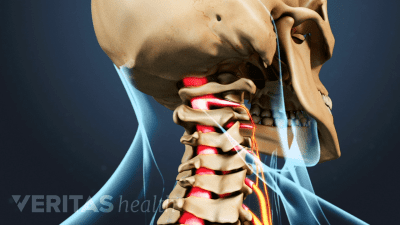A posterior cervical laminectomy is a surgical procedure designed to relieve pressure on the spinal cord caused by spinal stenosis.
Cervical spinal stenosis is a narrowing of the spinal canal that can compress the spinal cord and/or surrounding nerve roots.
This narrowing can be caused by degenerative changes in the cervical spine, or neck.
In a laminectomy surgery, a three- to four-inch vertical incision is made along the midline of the neck.
The paraspinal muscles are stripped away from the spinous processes, then moved out of the way with retractors.
A trough is cut on both sides of the affected lamina, just before it meets the adjacent facet joints, using a rotating wheel instrument called a high-speed burr.
The spinous process and lamina are removed as a single unit that resembles a lobster's tail. The removal procedure may repeat if more than one vertebra is involved in the spinal compression.
With the lamina and spinous process removed, the spinal cord floats back into the spinal canal and has more room to heal.
In some cases, a spinal fusion may be performed after the laminectomy.
In a cervical spinal fusion, two or more of the affected vertebrae are joined together into a single unit using a bone graft and possibly a supporting metal rod and screws.
The paraspinal muscles are then closed, protecting the spinal canal. The surgeon closes the incision. Some patients may need to wear a neck brace for a period of time following surgery.
Recommended for You
Editor’s Top Picks
- Cervical Stenosis with Myelopathy
- Anterior Cervical Discectomy and Fusion (ACDF) Video
- Cervical Spinal Stenosis Video
- Outpatient Posterior Cervical Foraminotomy and Discectomy
- Pain Management and Activity Restrictions after Cervical Spine Surgery
- Potential Risks and Adverse Events Associated with Cervical Spine Surgery







